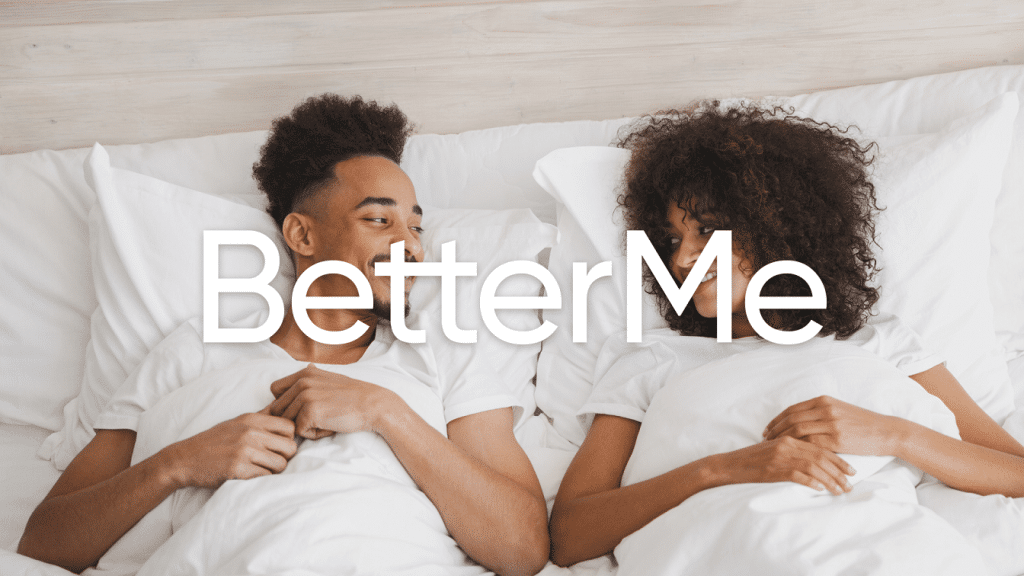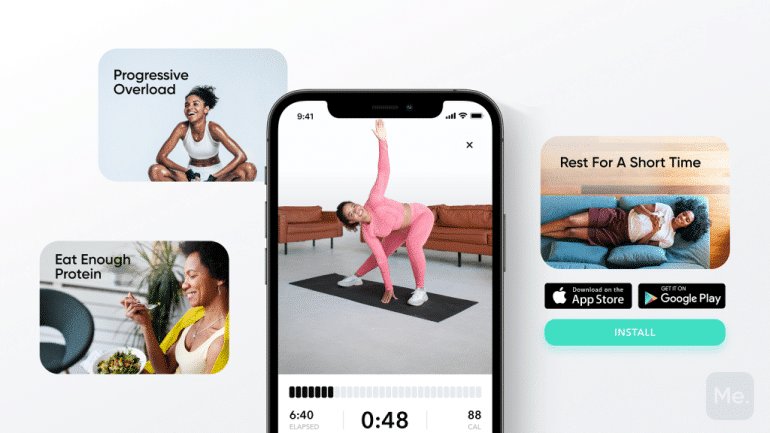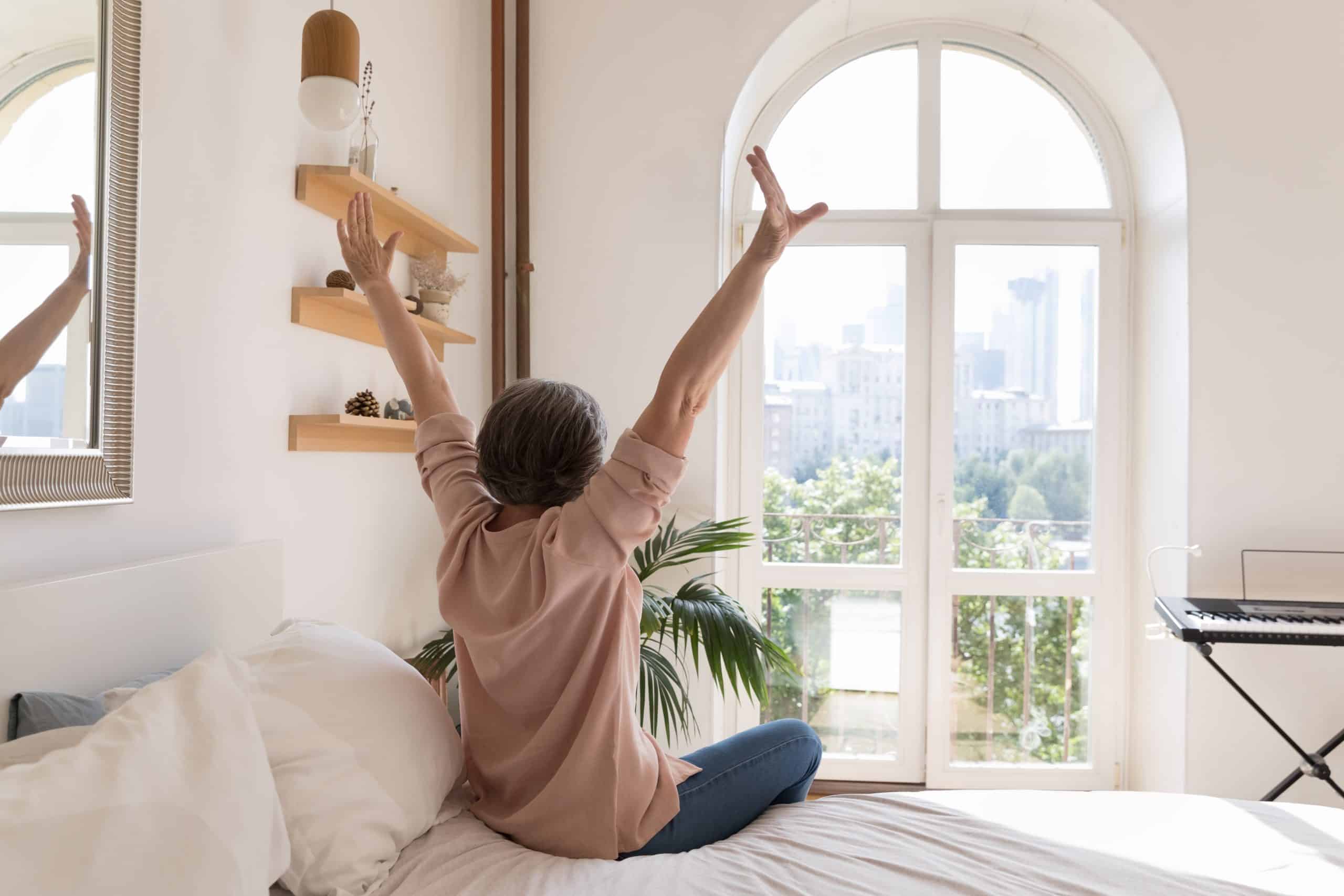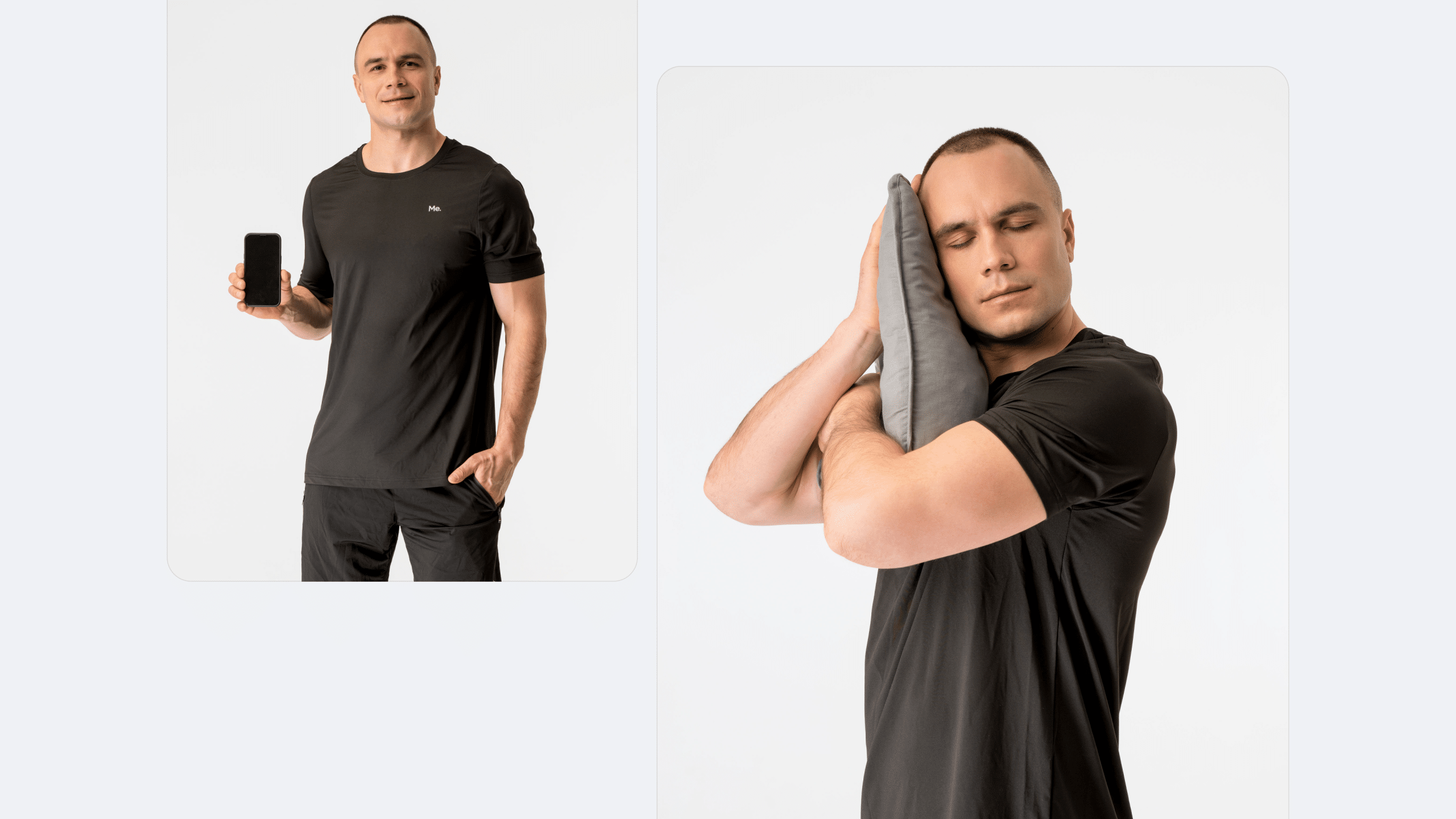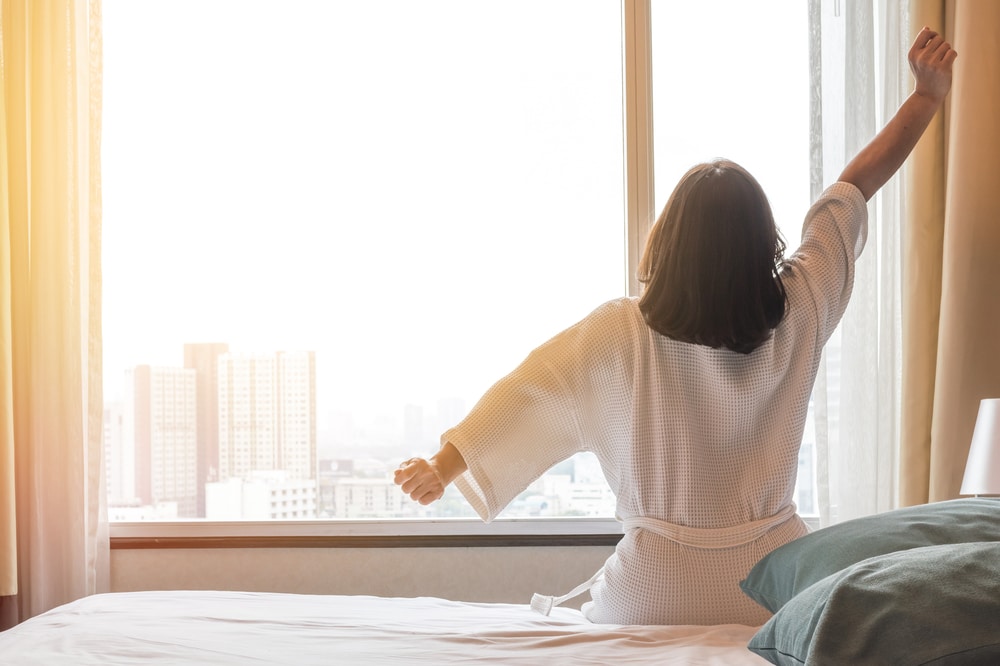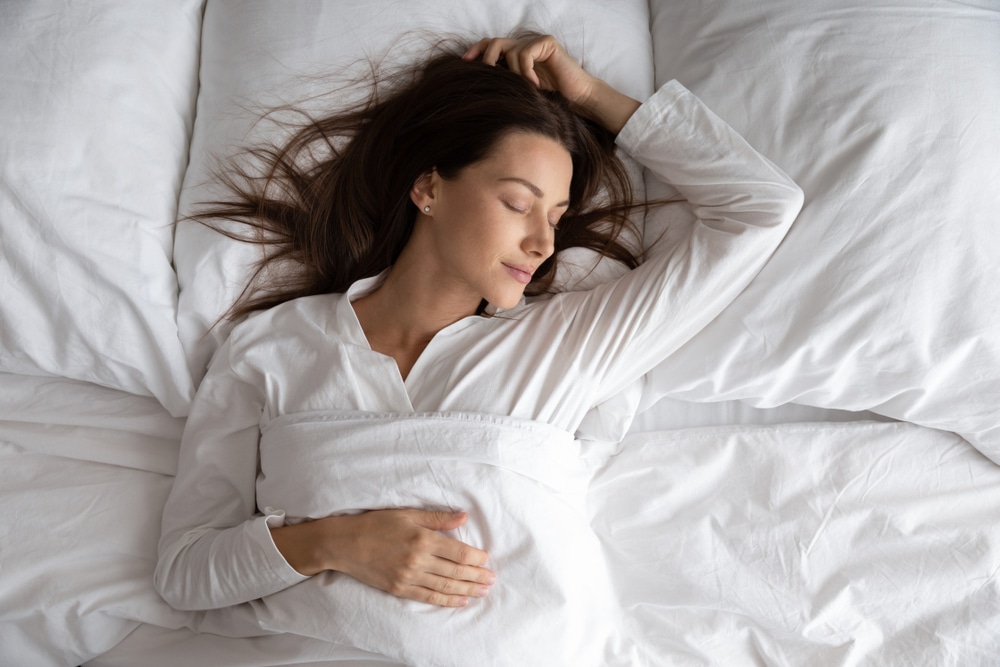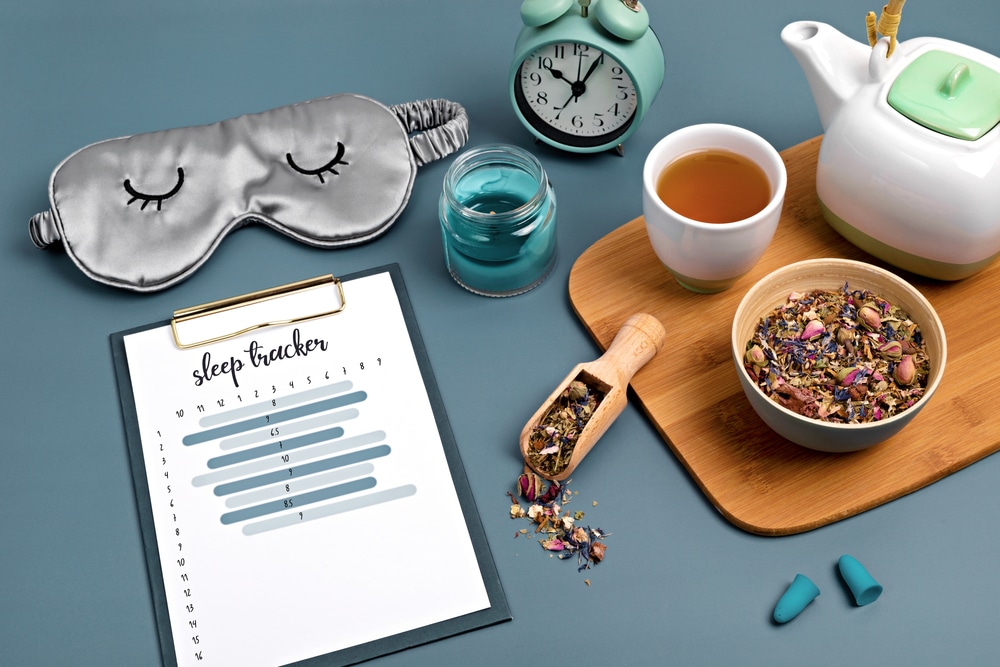The Sleep Foundation states that if you’re not falling asleep within 30 minutes of getting into bed, and only waking up once per night, you are likely experiencing sleep problems (13). That’s especially true if you wake up at night and it takes you more than 20 minutes to get back to sleep. While sleep problems might stem from deeper medical issues such as undiagnosed sleep disorders, they could also be due to lifestyle habits or environmental factors (10). And luckily these sleep problems can often be addressed with a few lifestyle changes and simple techniques. Read on for the best sleep tricks and tips to help you fall asleep and stay asleep.
Your Sleep Cycle And Why It Matters
On the surface level, a restful night might seem like a matter of getting into bed and simply falling asleep. But a restful night of sleep goes much deeper than that.
The average human experiences four to six sleep cycles throughout the night. Each cycle lasts about 90 minutes and consists of five distinct stages: four stages of non-rapid eye movement (NREM) sleep, followed by REM sleep (17).
Below is a breakdown of the different phases:
- Stage One NREM Sleep (1–7 minutes): Light sleep characterized by slow eye movements.
- Stage Two NREM Sleep (10–25 minutes): A deeper sleep characterized by slower brain waves.
- Stages Three and Four NREM Sleep (50–60 minutes): The deepest sleep, characterized by even slower brain waves.
- REM Sleep (time varies): A phase of active dreaming characterized by rapid eye movements.
The goal, then, is to move through all five stages as efficiently and naturally as possible. The following tips can help you get there.
1. Rely On Routine
The human body thrives on routine and habits. It’s easy to see why, especially where sleep is concerned. Two systems control sleep:
- The circadian rhythm, which is the body’s internal clock that tells it when to go to sleep and wake up (4).
- The homeostatic system, which is the body’s “sleep pressure” and signals when it needs more rest (19).
These two systems can get out of whack if you frequently change your sleep schedule, or if you suffer from jet lag.
To stay in sync with these two systems and get the best sleep possible, create a bedtime routine that you can get into the habit of following. Ideally, you want to go to bed at around the same time each night.
Sleep timing is key for maintaining the circadian rhythm (24). Considering that most adults need 7 to 9 hours of sleep each night, make sure that your bedtime is early enough to accommodate this.
You also want to avoid any activities that can make it harder to fall asleep in your bedtime routine. This includes any type of vigorous exercise, checking work emails, or scrolling through your phone (26).
Instead, focus on activities that can help you relax before bed such as taking a warm bath, reading a book, or stretching.
Read More: Having Trouble Sleeping? Here Are 3 Natural And Tech-Based Sleep Tricks
2. Optimize Your Sleep Environment
The environment in which you sleep can have a huge impact on how restful your sleep is (1). The bedroom should be a dark, quiet and cool place that is dedicated to rest. More specifically:
Set An Ideal Temperature
Start by keeping the temperature between 60 and 67 degrees Fahrenheit. According to the Sleep Foundation, this is the optimal temperature range for sleeping (22).
Reduce Noise
Since noise can be a major sleep disruptor, reduce any noise in your bedroom. If the room is too noisy, consider using earplugs or a white noise machine to drown out the sounds.
Block Out Light
Light can also interfere with sleep (8). Invest in blackout curtains that can help block out any external light.
A sleep mask is a nifty solution for blocking out any light that is coming from your electronics. Look for a sleep mask that’s made from soft and breathable material. It also has adjustable straps so it fits comfortably.
Dress Comfortably
Wear comfortable, breathable clothing or sleepwear. That way, you can stay cool and dry throughout the night without any extra hassle. Or otherwise warm and toasty, depending on the weather.
By optimizing your sleep environment, you can ensure that when you lay down in bed, the environment is conducive to sleep.
3. Choose The Best Mattress And Pillow
Sleep specialists agree that choosing the right mattress and pillow can make a world of difference (12) (27). Technically, this is one aspect of optimizing your sleep environment, but it deserves to be highlighted separately because of its importance.
When looking for a mattress and a pillow you need to keep an eye out for:
- Design: Quality mattresses should be breathable and made from the comfiest memory foam.
- Support: The mattress should support your body in the most anatomically correct position.
- Cooling: Look for a mattress with a hole-punch ventilated design that ensures a cooling effect.
Designed in collaboration with orthopedic specialists, it ensures an anatomically correct body position during sleep and has a breathable material that helps wick away moisture. It also has an extra soft outer cover for additional comfort.
4. Use Natural Light During The Day
Exposure to natural light during the day is essential for maintaining your circadian rhythm (7).
Here’s how it works: light triggers the release of a hormone called melatonin, which is responsible for making you feel sleepy. The more natural light you get during the day, the less melatonin your body will produce when it’s time to go to bed (7).
Make sure you get plenty of natural light during the day. You can do this by getting outside for a few minutes every day or opening your curtains during the daytime hours to let natural light stream in.
In the winter, you can also use a light box to simulate the effect of natural sunlight. Light boxes are designed to emit bright light that’s similar to outdoor light, without harmful UV rays (15).
If you wish to cinch your waist, tone up your bat wings, blast away the muffin top – our fitness app was created to cater to all your needs! BetterMe won’t give excess weight a chance!
5. Check Your Meal Quality And Timing
What we eat and when we eat can affect how well we sleep. Research has found that certain nutrients, such as carbohydrates, can help promote sleep (3).
Conversely, a diet that is high in sugar and caffeine can interfere with sleep. Spicy, greasy, and processed foods can also make it more difficult to sleep (20).
In terms of timing, eating too close to bedtime can interfere with sleep. Eating late can cause indigestion, increased heart rate, and abdominal discomfort (6).
Here are some tips for meal quality and timing:
- Eat a nutrient-dense diet: choose whole, one-ingredient foods such as vegetables, fruits, and lean proteins.
- Eat foods that promote sleep: include foods high in carbohydrates and tryptophan, such as oatmeal, dairy products, bananas, tuna, eggs, and nuts (21).
Also include foods high in magnesium and calcium, such as salmon, avocado, spinach, and pumpkin seeds (21). These foods are known to be natural sedatives.
- Avoid eating close to bedtime: make sure you finish your last meal at least 2-3 hours before bed.
- If you must, have a light snack before bed: choose something that is low in sugar and contains tryptophan and/or magnesium, such as half an avocado, almond butter on toast, or a banana with milk.
By following these tips you can optimize your meal quality and timing to ensure that it does not interfere with your sleep.
6. Be Smart About Daytime Naps
Napping can either be helpful or harmful, depending on how it is used (2).
If you are feeling sleep-deprived and need to catch up on your rest, then a nap can be beneficial. However, taking naps during the day can make it more difficult to fall asleep at night if they are not timed correctly and kept short.
If you do take a nap, make sure it is not too long – ideally no more than 30 minutes. It’s also best to nap earlier in the day (early afternoon is ideal) so that it does not interfere with your nighttime sleep.
7. Use Exercise To Improve Sleep
Research on the effect of exercise on sleep has found that it can greatly improve sleep quality. Regular physical activity is known to reduce stress and anxiety levels, which helps promote more restful sleep (9).
Exercise can also trigger physiological processes that help you fall asleep faster and stay asleep longer (14).
The recommendation is to get at least 150 minutes of moderate-intensity exercise per week, which is equivalent to 30 minutes a day for 5 days (11). This doesn’t have to be intense exercise – a brisk walk or bike ride can do the trick.
If you’re able to put in more than 150 minutes per week, then that’s even better.
A note about the timing of exercise for good sleep—it’s best to do it 3-4 hours before bedtime so that your body has enough time to rest and cool down.
Exercising too close to bedtime can make it more difficult to fall asleep because it can raise your body temperature and make you more alert (20).
Read More: Sleeping With Legs Elevated: Why And How To Do It
8. Check Your Medication
If you’ve recently started having trouble sleeping, it could be related to the medication you are taking. Some medications can cause side effects such as insomnia and restless leg syndrome which can interfere with sleep (25).
If you are taking any medication, talk to your doctor or pharmacist about possible side effects and how they might affect your sleep. Your doctor may be able to adjust the dose or switch to a different medication.
9. Check Your Symptoms
Recent statistics on the prevalence of sleep disorders show that up to 50 to 70 million Americans suffer from some type of sleep disorder (10). Unfortunately, many of these people don’t realize they have a sleep disorder.
If you are having trouble sleeping, it’s important to discuss your symptoms with a healthcare provider to determine if you have an underlying sleep disorder. Don’t know what exactly to look out for?
Common symptoms of sleep disorders include difficulty falling asleep, waking up often during the night, and feeling tired upon waking in the morning. In addition, chronic snoring and sleep apnea (pauses in breathing during sleep) are both signs of a potential sleep disorder (18).
If you think you may have a sleep disorder, talk to your doctor. They can help you get an accurate diagnosis and develop a treatment plan that’s tailored to your individual needs.
BetterMe is your fast-track ticket to a long-lasting weight loss! Tailor your fitness journey and maximize your results with just a couple of swipes!
10. De-Stress And Mentally Recharge
Stress and anxiety can have a big impact on our ability to fall asleep and stay asleep. Research shows that people with higher levels of stress and anxiety tend to have more difficulty falling asleep and staying asleep than those without (23).
While more serious mental health issues such as depression and anxiety disorders should be treated by a professional, there are some things you can do to help de-stress and mentally recharge.
For example, practicing mindfulness meditation can help you relax and clear your mind before bed.
Mindfulness is a form of meditation that focuses on being present in the moment and can be done for just a few minutes each day (16). Other activities that can help you relax include reading, journaling, and listening to soothing music.
The Bottom Line
A good night’s sleep is essential for our overall health and well-being, but unfortunately, it’s not always easy to come by. Thankfully, there are a few things you can do to help improve your sleep.
SleepMe, the revolutionary design crafted with breathable material and memory foam, is a great place to start. Coupled with good sleep hygiene habits such as keeping a regular sleep schedule, avoiding caffeine in the afternoon and evening, and de-stressing before bedtime, you can set yourself up for a great night’s sleep.
DISCLAIMER:
This article is intended for general informational purposes only and does not address individual circumstances. It is not a substitute for professional advice or help and should not be relied on to make decisions of any kind. Any action you take upon the information presented in this article is strictly at your own risk and responsibility!
SOURCES:
- Bedroom Environment: What Elements Are Important? (2022, sleepfoundation.org)
- Benefits and risks of napping in older adults: A systematic review (2022, frontiersin.org)
- Carbohydrate and sleep: An evaluation of putative mechanisms (2022, frontiersin.org)
- Circadian Rhythms (n.d., nigms.nih.gov)
- Deep Dream Cervical Pillow | with upgraded memory foam (n.d., store.betterme.world)
- Does the Proximity of Meals to Bedtime Influence the Sleep of Young Adults? A Cross-Sectional Survey of University Students (2020, mdpi.com)
- Effect of Light on Human Circadian Physiology (2010, ncbi.nlm.nih.gov)
- Effects of light on human circadian rhythms, sleep and mood (2019, link.springer.com)
- Exercise can improve sleep quality: a systematic review and meta-analysis (2018, ncbi.nlm.nih.gov)
- Extent and Health Consequences of Chronic Sleep Loss and Sleep Disorders (2006, ncbi.nlm.nih.gov)
- How much physical activity do adults need? (2022, cdc.gov)
- Improving the quality of sleep with an optimal pillow: a randomized, comparative study (2014, pubmed.ncbi.nlm.nih.gov)
- Insomnia: Symptoms, Causes, and Treatments (2022, sleepfoundation.org)
- Interrelationship between Sleep and Exercise: A Systematic Review (2017, hindawi.com)
- Light Therapy: Can Light Combat Insomnia? (2022, sleepfoundation.org)
- Mindfulness Meditation and Psychopathology (2019, ncbi.nlm.nih.gov)
- Physiology, Sleep Stages (2006, ncbi.nlm.nih.gov)
- Sleep Disorder (2022, ncbi.nlm.nih.gov)
- Sleep Homeostasis, Metabolism, and Adenosine (2015, link.springer.com)
- Sleep Quality: A Narrative Review on Nutrition, Stimulants, and Physical Activity as Important Factors (2022, mdpi.com)
- Strategies of Functional Foods Promote Sleep in Human Being (2014, ncbi.nlm.nih.gov)
- The Best Temperature for Sleep: Advice & Tips (2022, sleepfoundation.org)
- The impact of stress on sleep: Pathogenic sleep reactivity as a vulnerability to insomnia and circadian disorders (2018, ncbi.nlm.nih.gov)
- Timing is everything: Circadian rhythms and their role in the control of sleep (2022, sciencedirect.com)
- Trends in the use of medications with insomnia side effects and the implications for insomnia among US adults (2020, onlinelibrary.wiley.com)
- What Causes Insomnia? (2022, sleepfoundation.org)
- What type of mattress should be chosen to avoid back pain and improve sleep quality? Review of the literature (2021, springeropen.com)


